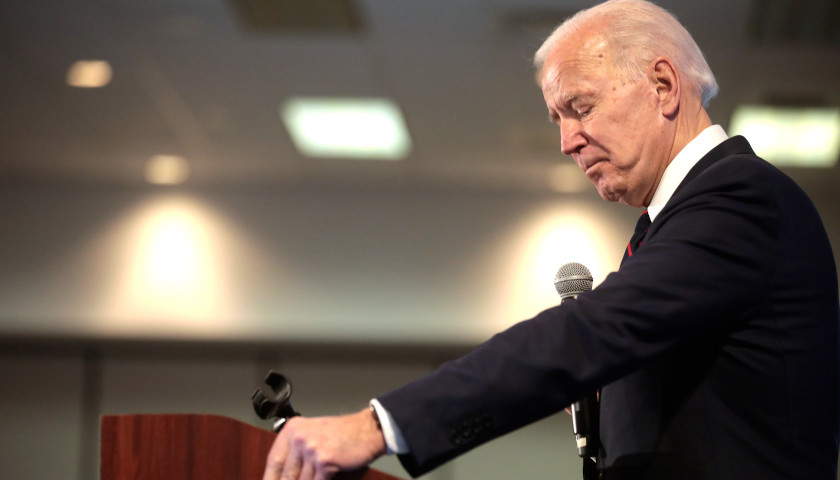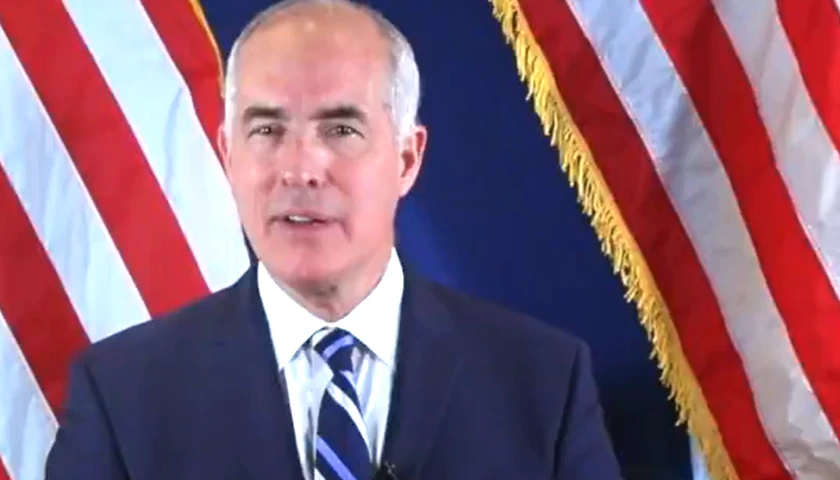by Julie Kelly
Joe Biden often brags that he was Barack Obama’s foreign affairs consigliere during their eight years together in the White House.
“One of the reasons Barack Obama picked me as vice president is because he lacked the background in foreign policy,” Biden told an NPR reporter in December. “He knew what he wanted to do, he knew how to get it done. But notice every time we had a problem on Capitol Hill, who went up and got it fixed?” Biden, of course, was referring to himself.
But as Obama’s legacy on international affairs implodes under the glare of Donald Trump’s brighter achievements, the role of Obama’s self-proclaimed BFF and global guru deserves long-delayed scrutiny. And no other Obama-era debacle merits more scrutiny than the war in Afghanistan, America’s longest-running war that continues to cost young lives and tens of billions in U.S. tax dollars each year.
In an explosive series published last month in the Washington Post, “The Afghanistan Papers” provides firsthand accounts from the war’s closest managers. Dozens of interviews offer insight into how the conflict has been mishandled from the start; how intelligence has been politicized; and how top officials, including former commanders-in-chief, have deceived the public and Congress about the real status of the war.
The Post series raises tough questions for Biden, too. As a top senator and then vice president, he has been a key figure in the disastrous conflict for longer than anyone else in Washington. Biden’s fingerprints can be found on nearly every aspect of the war, from authorizing the 2001 invasion to initiating expensive, failed reconstruction efforts and supporting his BFF’s escalation of the conflict during Obama’s first term.
If he wins the White House and Trump fails to bring all our troops home, Joe Biden will inherit a war he blessed nearly two decades before.
Revising the Record
Biden, as is his habit, now is trying to rewrite his own history, particularly his alleged objection to Obama’s “surge” that sent tens of thousands more U.S. troops into the war zone.
One decade ago this month, the troop surge authorized by the Obama-Biden White House began in Afghanistan. The Pentagon, acting on President Obama’s orders, began deploying more than 30,000 additional troops to reverse the deteriorating situation in that country at the time.
Obama announced his decision in December 2009 after months of internal debate among his top advisors and military brass over competing proposals. Biden was closely involved in the deliberations.
Obama settled on a compromise plan; fewer troops than the U.S. commander in Afghanistan, General Stanley McChrystal, wanted but more than Biden had recommended.
Obama, a commander-in-chief with no military experience, also insisted on an 18-month timetable before a mandatory drawdown would commence, regardless of success. Troops would start coming home, coincidentally, just as Obama and Biden launched their 2012 reelection campaign.
Biden, also lacking military service and the recipient of five student draft deferments during the Vietnam War, had pushed for a smaller footprint and a quick exit even though he had proposed a surge during his 2008 run for president. Biden at the time called Obama, his Democratic primary opponent, a “Johnny-come-lately” for endorsing his proposal to redirect troops from Iraq to Afghanistan. “If we surge troops anywhere, it should be in Afghanistan,” Biden said on the campaign trail in 2007.
But Biden transformed into a skeptic in 2008 after visiting the war-torn nation and a publicized blow-up with Hamid Karzai, the country’s leader at the time. As vice president, Biden resisted plans to send upwards of 40,000 American soldiers to Afghanistan, the initial strategy endorsed by Obama’s military chiefs in 2009.
Now that the Afghanistan papers have prompted renewed public interest in the ongoing war, Biden is backtracking on his involvement in Obama’s surge strategy. During a debate last month, Biden claimed, “I’m the guy, from the beginning, who argued that it was a big, big mistake to surge forces to Afghanistan. Period. We should not have done it and I argued against it constantly.”
That’s not the full story.
“No One Said Anything”
Although Biden opposed the military’s 40,000-plus troop build-up, he did not reject the idea of adding more troops. According to the book, Little America: The War Within the War for Afghanistan by Rajiv Chandrasekaran which chronicled the pre-surge planning and execution, Biden in fact supported a plan to send 20,000 more troops to Afghanistan.
While Obama considered his options, Biden prepared a memo that outlined his concerns and offered an alternative. “Biden…did not want to cut and run,” Chandrasekaran wrote. “[He] was willing to send about 20,000 additional troops so long as they were focused on training the Afghan army and conducting missions to kill or capture Taliban leaders.”
Chandrasekaran called Biden’s alternative a “limited surge.”
And when “No Malarkey” Joe had the chance to object to sending tens of thousands of young Americans halfway around the world to fight a losing war that had been deprioritized for another war that Biden backed—the Iraq war—the vice president was uncharacteristically silent. In a New York Times article published in December 2009, reporter Peter Baker described the meeting between Obama’s national security team right before the president signed off on the final plan.
Obama asked each adviser, including Biden, to register any disagreement. “‘If you do not agree with me, say so now,’ Obama told the group assembled in the Oval Office the Sunday after Thanksgiving 2009. ‘There was a pause and no one said anything,’” Baker wrote.
Obama reiterated his request. “‘Tell me now,’ he repeated. Biden asked only if this constituted a presidential order.” So, contrary to his tough talk on the campaign trail, Joe Biden, when given the final chance, did not tell Obama that he opposed the surge.
Troop levels hit an all-time high the following year, bringing the U.S. troop presence in Afghanistan to more than 100,000 by the end of 2010. As fighting escalated between 2010 and 2012, more than 1,200 American soldiers were killed, representing over half the total number of U.S. casualties in the 18-year conflict.
In January 2011, Biden met with Karzai and touted the surge’s success. “[We] have a strategy and the resources in place to accomplish the goal of a stable and growing and independent Afghanistan able to provide for its own security,” Biden said. The vice president reiterated the July 2011 drawdown of troops—a deadline that Biden had demanded—but assured Karzai that “we are not leaving, if you don’t want us to leave.”
(In his interview published in the Washington Post, General David Petraeus—who took over command of U.S.-NATO forces in Afghanistan in June 2010—criticized both the inadequate surge level and the brief timetable. “We hoped for an extended surge, and we also had not discussed the speed of the drawdown, so I hoped for a slow one,” Petraeus said. He claimed Obama “sprung” the deadline on top commanders before approving the surge, which created other problems. “What drove spending was the need to solidify gains as quickly as we could, knowing that we had a tight drawdown timeline. . . . And we wound up spending faster than we would have if we felt we had forces longer than we did.”)
$1 Trillion and Counting
But the surge didn’t work. It’s hard to say whether McChrystal’s plan for more troops and a lengthier timeline would have fared better, but one thing appears certain: Joe Biden’s half-measure guided by a politically-motivated deadline undoubtedly would have failed just as badly, if not worse, as Obama’s plan did. Further, Biden’s calculation was the baseline for Obama’s compromise plan as the president met his military chiefs and his vice president in the middle.
And Obama stuck with Biden’s deadline; troop levels began to drop drastically in late 2011: Obama had to halt plans to completely withdraw as the Taliban gained ground toward the end of Obama’s presidency.
An unidentified national security advisor for Obama confirmed the team’s poor planning in his interview with the special inspector general for Afghanistan: “We did a very good job of pushing information from the field up to the principals. Where we fell short is pushing decisions back down to the field. I’ll always remember reading [Bob] Woodward’s book [Obama’s Wars] . . . and turning to the back of the book where there was a copy of the strategy. and slapping my forehead, saying ‘Oh, that was the strategy?!’”
The war, sadly, rages on. U.S. casualties hit their highest level last year since 2014. Civilian deaths are rising, too. Corruption is rampant and the opiate industry is thriving. Most Americans—including veterans—now consider the war a mistake. The taxpayers’ tab is $1 trillion and climbing.
The public is learning more from the people closest to the decision-makers about what a debacle the whole operation has been from the start. (Take a moment and watch this clip from John Sopko, the special inspector general for Afghanistan reconstruction, who testified before Congress last week.)
No presidential team has led the war effort longer than Barack Obama and Joe Biden. Three-quarters of the 2,351 American fatalities in Afghanistan happened on Obama’s watch. And while Trump faces condemnation for his alleged rude comments to top commanders about the war, Biden is allowed to misrepresent his past position and escape the comeuppance he deserves.
It’s easy for him now to claim that he would order troops home if he’s elected president. But first, Biden needs to account for the disaster that he and his BFF created—and left for Donald Trump to clean up.
– – –
Julie Kelly is a political commentator and senior contributor to American Greatness. Her past work can be found at The Federalist and National Review. She also has been featured in the Wall Street Journal, The Hill, Chicago Tribune, Forbes, and Genetic Literacy Project. After college graduation, she served as a policy and communications consultant for several Republican candidates and elected officials in suburban Chicago. She also volunteered for her local GOP organization. After staying home for more than 10 years to raise her two daughters, Julie began teaching cooking classes out of her home. She then started writing about food policy, agriculture, and biotechnology, as well as climate change and other scientific issues. She graduated from Eastern Illinois University in 1990 with a degree in communications and minor degrees in political science and journalism. Julie lives in suburban Chicago with her husband, two daughters, and (unfortunately) three dogs.
Photo “Joe Biden” by Gage Skidmore. CC BY-SA 2.0.




